
Virtua Fighter is a fighting game developed and published by Sega for arcades. It was developed for the Sega Model 1 arcade platform by AM2, a development group within Sega headed by Yu Suzuki. An early prototype version was location tested in Japan by August 1993, before the complete game was released worldwide in December 1993. It was the first arcade fighting game to feature fully 3D polygon graphics. The game was ported to Sega Saturn as a global launch title in 1994 and 1995, and also received a port to the Sega 32X.
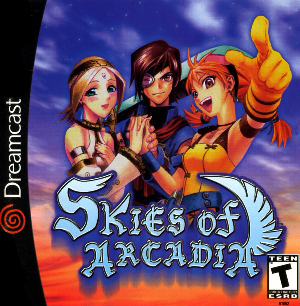
Skies of Arcadia is a 2000 role-playing video game developed by Overworks and published by Sega for the Dreamcast. Players control Vyse, a young air pirate, and his friends as they attempt to stop the Valuan Empire from reviving ancient weapons with the potential to destroy the world.
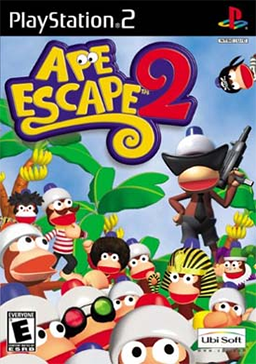
Ape Escape 2 is a 2002 platform game developed and published by Sony Computer Entertainment for the PlayStation 2. It was released in Japan in July 2002, Europe in March 2003 and North America in July 2003 by Ubi Soft. It is the second main installment of the Ape Escape series, and the second game in the series to be on the PlayStation 2 after Pipo Saru 2001. It was also used as the basis for the animated series by Frederator Studios.
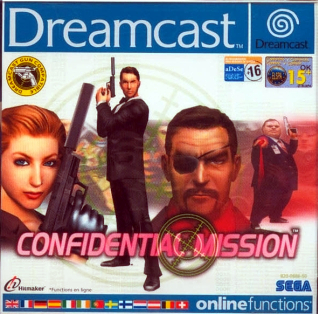
Confidential Mission is a light gun game published by Sega, first available as an arcade game, then ported to the Dreamcast. The game is in the same style as the Virtua Cop series or The House of the Dead series, with support for one or two players. The game was developed by Sega's Hitmaker development team and first released in 2000. Its plot is of the same vein as James Bond and Mission: Impossible. Despite it also having an arcade release, it never enjoyed the popularity of the Virtua Cop nor The House of the Dead series, which were also produced by Sega.

Konami Krazy Racers is a 2001 kart-themed racing video game published and developed by Konami for the Game Boy Advance, released as a launch title for the system. Konami Krazy Racers makes use of a variety of characters and concepts from several of Konami's franchises, including Castlevania, Metal Gear, and Gradius. It plays similarly to the Mario Kart series, with eight characters per circuit and offensive/defensive items placed at predetermined points in the tracks. Konami Krazy Racers received mostly positive reviews. It was later released through the Virtual Console for Wii U in 2015.

Gotcha Force is a fighting / third-person shooter video game developed and published by Capcom for the GameCube in 2003. The game consists primarily of collecting gacha toys and battling with them.

Ape Escape is a series of video games developed primarily by Japan Studio and published and owned by Sony Interactive Entertainment. The series incorporates ape-related humour, unique gameplay, and a wide variety of pop culture references. The first game in the series is the first game to require the DualShock or Dual Analog controller to play.
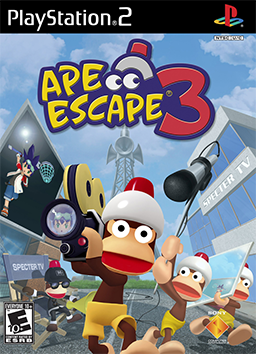
Ape Escape 3 is a 2005 platform video game developed and published by Sony Computer Entertainment for the PlayStation 2.
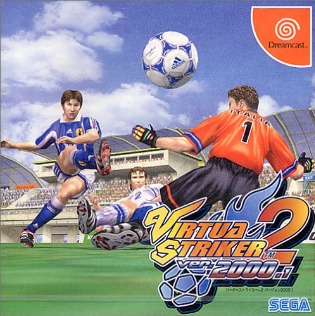
Virtua Striker 2 is a sports video game developed and published by Sega for arcades in 1997. It is the sequel to the 1994 video game Virtua Striker, and the second game in the Virtua Striker series. A series of updates was released from 1998 to 1999, starting with Virtua Striker 2 ver. 1998 and ending with Virtua Striker 2 ver. 2000.1, that latest update being released for the Dreamcast in Japan in 1999, and then internationally in 2000, with the North American version re-titled to Virtua Striker 2. A sequel, Virtua Striker 3, was released in 2001.
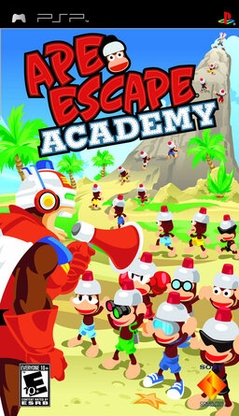
Ape Escape Academy, also known as Ape Academy in Europe and Piposaru Academia: Dossari! Sarugē Daizenshū in Japan, is a party video game developed by Shift and Alvion and published by Sony Computer Entertainment for the PlayStation Portable. It consists of a collection of 47 mini-games, many of which borrow from elements of Ape Escape 2. The game was first released in Japan in 2004, in Europe in 2005 and North America in 2006. By utilizing the PSP's Wi-Fi capabilities, up to 4 players can play at a time. The North American release was on the same day as Ape Escape 3.

Escape from Bug Island, titled Necro-Nesia in Japan, is a survival horror video game developed by Spike and released for the Wii in 2006.

Nagano Winter Olympics '98, known in Japan as Hyper Olympics in Nagano, is a multi-event sports game from Konami. It is based on the 1998 Winter Olympics and features 10 Olympic events including skating, skiing, luge, bobsleigh, slalom, curling, halfpipe and snowboarding. The game is part of the Track & Field/Hyper Sports series and would be the last licensed Olympic video game released on a Nintendo home console until Mario & Sonic at the Olympic Games about nine years later.
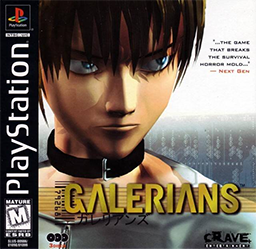
Galerians is a 1999 survival horror video game developed by Polygon Magic for the PlayStation. The game follows a boy named Rion who discovers he has psychic powers. He has amnesia, and in the process of learning his identity, he discovers that he is humanity's last hope for survival against the Galerians, genetically enhanced humans. The game has a sequel, Galerians: Ash on PlayStation 2.

Pipo Saru 2001 is a 2001 action video game developed and published by Sony Computer Entertainment for the PlayStation 2. A spin-off and the second game in the Ape Escape series, it was released only in Japan; a true sequel, Ape Escape 2, was released internationally for the PlayStation 2 in 2002.

Ape Escape is a 1999 platform game developed and published by Sony Computer Entertainment for the PlayStation. The first game in the Ape Escape series, the game tells the story of an ape named Specter who gains enhanced intelligence and a malevolent streak through the use of an experimental helmet. Specter produces an army of apes, which he sends through time in an attempt to rewrite history. Spike, the player character, sets out to capture the apes with the aid of special gadgets.

PlayStation Move Ape Escape, simply titled Ape Escape in Europe and known in Asian countries as Ape Escape: On the Move!, and in Japan as Furi Furi! Saru Get You, is a 2010 rail shooter and party video game developed by Japan Studio and published by Sony Computer Entertainment for the PlayStation 3. The game was originally announced at the Tokyo Game Show 2009 as one of the title supporting the PlayStation Move controller. The title was released on December 9, 2010, in Japan, then in 2011 on June 24 for Europe, and on July 5 for North America. An English version of the game in Asia was also released January 31, 2011.

GunGriffon Blaze is a video game developed by Game Arts and published by Capcom and Working Designs in 2000, and by Swing! Deutschland in Europe in 2002 for PlayStation 2. The game was a launch title on the PlayStation 2 in North America.

Wakeboarding Unleashed Featuring Shaun Murray is an extreme sports video game developed by Shaba Games, Small Rockets and Beenox, and published by Activision under the Activision O2 label and Aspyr for Game Boy Advance, Macintosh, Microsoft Windows, PlayStation 2, Xbox and mobile phones in 2003. It features wakeboarder Shaun Murray.

FIFA 2001 is a football simulation video game and the sequel to FIFA 2000. It was succeeded by FIFA Football 2002. It features Paul Scholes on the UK cover and Ben Olsen on the North American cover. The game's Spanish cover features Gaizka Mendieta on it. It was released on 31 October 2000 for Microsoft Windows and PlayStation, and on 24 November 2000 for PlayStation 2 as a launch title in Europe. The PlayStation 2 version was originally slated for release in the U.S. on 7 November, before it was delayed to 28 November. A Game Boy Color version was planned but cancelled.
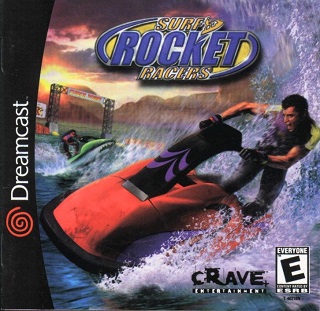
Surf Rocket Racers, known in Japan as Power Jet Racing 2001, is a video game developed and published by CRI Middleware and Crave Entertainment for Dreamcast in 2000-2001.




















